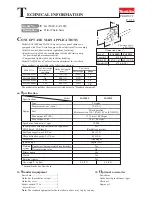
6
5.0
Glossary
Arbor:
Metal shaft that connects the drive
mechanism to the blade.
Bevel Edge Cut:
Tilt of the saw arbor and blade
between 0° and 45° to perform an angled cutting
operation.
Blade Guard:
Mechanism mounted over the saw
blade to prevent accidental contact with the cutting
edge.
Crosscut:
Sawing operation in which the miter
gauge is used to cut across the grain of the
workpiece.
Dado Blade:
Blade(s) used for cutting grooves and
rabbets. A stacked dado set can be used for wider
grooves.
Dado Cut:
Flat bottomed groove in the face of the
workpiece made with a dado blade.
Featherboard:
Device used to keep a board
against the rip fence or table that allows the
operator to keep hands away from saw blade.
Freehand:
Moving the workpiece into the blade
using only the hands, without a fixed positioning
device. (This is a dangerous, unacceptable
procedure –
always
use appropriate devices to
feed the workpiece though the saw blade during
cutting operations.)
Kerf:
The resulting cut or gap made by a saw
blade.
Kickback:
An event in which the workpiece is lifted
up and thrown back toward an operator, caused
when a workpiece binds on the saw blade or
between the blade and rip fence (or other fixed
object). To minimize or prevent injury from
kickbacks, see the
Operations
section.
Miter Gauge:
A component that controls the
workpiece movement while performing a crosscut
of various angles.
Non-Through Cut:
A sawing operation that
requires the removal of the blade guard and
standard riving knife, resulting in a cut that does
not protrude through the top of the workpiece
(includes Dado and rabbet cuts).
The blade guard and riving knife must be re-
installed after performing a non-through cut to
avoid accidental contact with the saw blade during
operation.
Parallel:
Position of the rip fence equal in distance
at every point to the side face of the saw blade.
Perpendicular:
90° (right angle) intersection or
position of the vertical and horizontal planes such
as the position of the saw blade (vertical) to the
table surface (horizontal).
Push Board/Push Stick:
An instrument
used to
safely push the workpiece through the cutting
operation.
Rabbet:
A cutting operation that creates an
L-shaped channel along the edge of a board.
Rip Cut:
A cut made along the grain of the
workpiece.
Riving Knife:
A metal plate fixed relative to the
blade, which moves with the blade as cutting depth
is adjusted. Thus, it maintains not only the kerf
opening in the workpiece, but also the knife-to-
blade distance. A
low-profile
riving knife is used
when performing a non-through cut because it sits
lower than the top edge of the blade.
Splitter (Spreader):
A stationary metal plate to
which the blade guard is attached that maintains
the kerf opening in the workpiece when performing
a cutting operation.
Standard Kerf:
1/8" gap made with a standard
blade.
Straightedge:
A tool used to check that a surface
is flat or parallel.
Through Sawing:
A sawing operation in which the
workpiece thickness is completely sawn through.
Proper blade height usually allows 1/8" of the top
of blade to extend above the wood stock. Keep the
blade guard down, the anti-kickback pawls down,
and the riving knife in place over the blade.
Summary of Contents for XACTA JTAS-12-DX
Page 19: ...19 12 1 1 Table and Cabinet Assembly JTAS 12 DX Exploded View...
Page 22: ...22 12 2 1 Trunnion and Motor Assembly JTAS 12 DX Exploded View...
Page 25: ...25 12 3 1 Blade Guard Assembly JTAS 12 DX Exploded View...
Page 27: ...27 13 0 Electrical Connections...
Page 28: ...28 427 New Sanford Road LaVergne Tennessee 37086 Phone 800 274 6848 www jettools com...







































